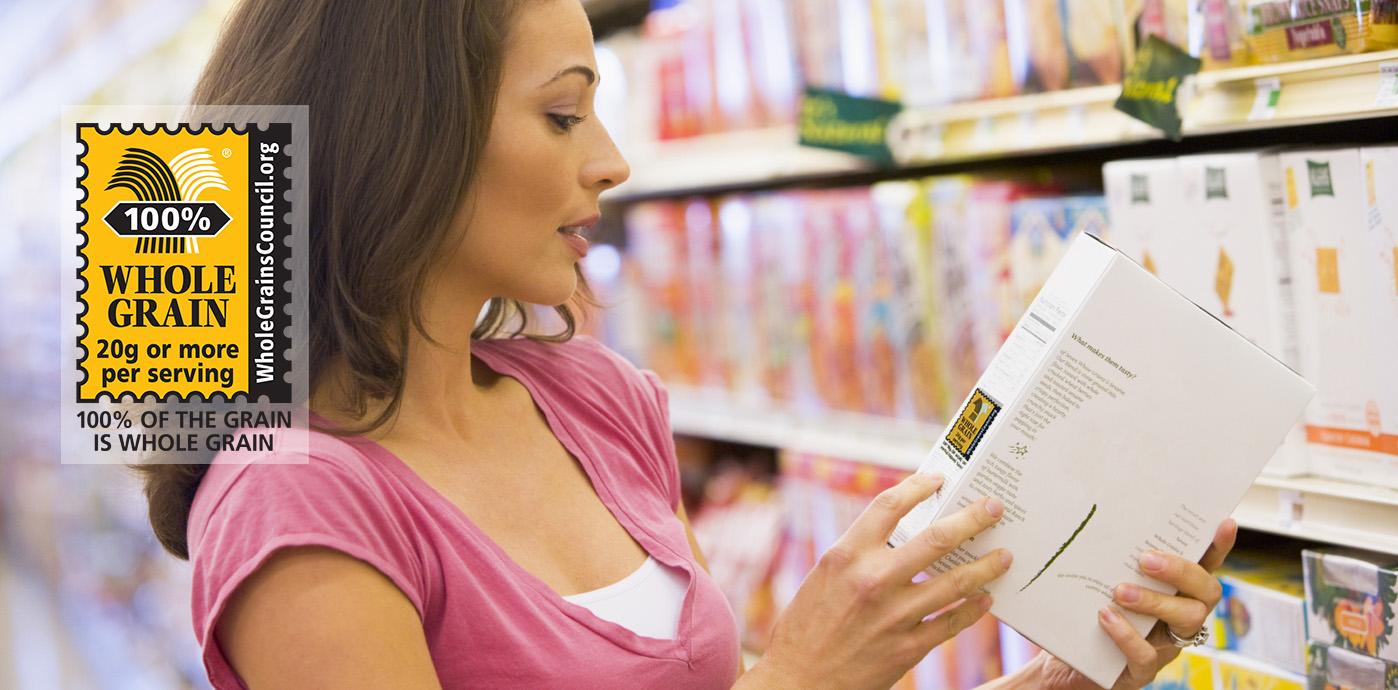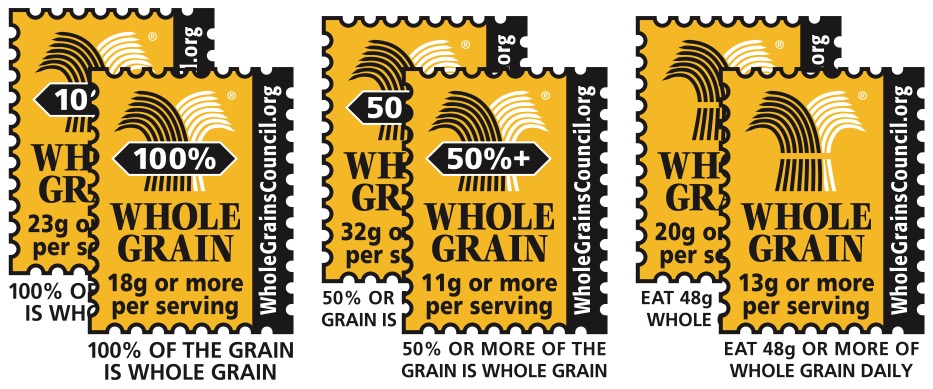An Aid for Busy Shoppers
The Whole Grain Stamp features a stylized sheaf of grain on a golden-yellow background with a bold black border. Its eye-catching design makes the Whole Grain Stamp easy to spot on food packages. Busy shoppers welcome this easy shortcut for finding products offering at least a half serving of whole grains. Click here to download a narrated PowerPoint explaining how and why we developed the Whole Grain Stamp.
100% Stamp, 50%+ Stamp or Basic Stamp?
There are three different varieties of the Whole Grain Stamp: the 100% Stamp, the 50%+ Stamp, and the Basic Stamp.
-
If a product bears the 100% Stamp (left image below), then all its grain ingredients are whole grain. There is a minimum requirement of 16g (16 grams) – a full serving – of whole grain per labeled serving, for products using the 100% Stamp.
-
If a product bears the 50%+ Stamp (middle image), then at least half of its grain ingredients are whole grain. There is a minimum requirement of 8g (8 grams) – a half serving – of whole grain per labeled serving, for products using the 50%+ Stamp. The 50%+ Stamp was added to the Whole Grain Stamp family in January of 2017, and began appearing on products in the spring and summer of 2017.
-
If a product bears the Basic Stamp (right image), it contains at least 8g (8 grams) – a half serving – of whole grain, but may contain more refined grain than whole.
Each Stamp also shows how many grams of whole grain ingredients are in a serving of the product. When you look at Stamped products on your grocery shelves you’ll see a wide range of gram amounts, reflecting the whole grain content of a serving of that specific product. If a product contains large amounts of whole grain (23g, 37g, 41g, etc.) but also contains extra bran, germ, or refined flour, it will use the 50%+ Stamp or the Basic Stamp (and not the 100% Stamp).
| THE 100% STAMP | the 50%+ Stamp | THE BASIC STAMP |
|---|---|---|
| For products where ALL of the grain is whole grain. |
For products where at least 50% of the grain is whole grain. |
For products that contain a significant amount of whole grain, but which contain primarily refined grain.* |
| Minimum requirement: 16g (16 grams) whole grain per serving. (a full serving of whole grain) | Minimum requirement: 8g (8 grams) whole grain per serving. (one half serving of whole grain) |
Minimum requirement: 8g (8 grams) whole grain per serving. (one half serving of whole grain) |
* From 2005 through 2016, before the introduction of the 50%+ Stamp, Basic Stamp products may have contained up to 99% whole grain. Until all packaging is updated, you may see products bearing the Basic Stamp with more than 50% of their grain as whole grain!
A few examples. Let’s play “name that stamp”
Let’s say you have four breakfast cereals sitting on a shelf. They each have a serving size of 30 grams, but they’re made up of different ingredients. Imagine you could look behind the scenes and know just how much of each ingredient each cereal contained.
- Cereal A: whole oats (22 grams), walnuts (5 grams), raisins (3 grams)
- Cereal B: whole oats (27 grams), oat bran (3 grams)
- Cereal C: whole oats (15 grams), walnuts (7 grams), raisins (5 grams), coconut (3 grams)
- Cereal D: corn flour (12 grams), whole oats (9 grams), raisins (5 grams), sugar (4 grams)
Cereal A
This cereal would qualify for the 100% Stamp, 22g or more.
All its grains are whole grain, and it contains more than 16g of whole grain.
Cereal B
This cereal would qualify for the 50%+ Stamp, 27g or more.
Although bran is a very healthy part of all intact grains, it’s not a WHOLE grain, so we can’t use the 100% Stamp on this product. Still, 90% of its grain ingredients are whole grain, so it earns the 50%+ Stamp.
Cereal C
This cereal would also qualify for the 50%+ Stamp, 15g or more.
All its grain is whole grain, but it doesn’t meet the minimum of 16g of whole grain required for the 100% Stamp.
Cereal D
This cereal would qualify for the Basic Stamp, 9g or more.
The first ingredient is corn flour, a refined grain, and it contains more refined grain than whole grain. Cereal D isn’t nearly as healthy as the first three examples, but with 43% of its grain as whole grain, and 4g (about 1 teaspoon) of sugar, it might be a good first step toward change for someone who has always eaten cereals with no whole grain and 12g of sugar (that’s 3 teaspoons!). It’s all about starting where you are, and working your way to better food choices.
You Do the Math… It’s Simple
With the Whole Grain Stamp, you don’t need to study ingredients or count grams and ounces to meet the whole grain goals in the latest government guidelines. The Stamp makes it easy to get your recommended three servings or more of whole grains each day:
-
Eat three whole grain food products labeled “100% Whole Grain” OR
-
Eat six products bearing ANY Whole Grain Stamp
It’s simple. All you need to do is look for the Stamp. But if you enjoy knowing just how much whole grain is in the products you’re eating, the Whole Grain Stamp provides that information, while also reminding you to aim for at least 48g (48 grams) of whole grain overall, each day.
Original Whole Grain Stamps — an historic note
Packaging printed earlier than mid-2006 showed an earlier version of the Whole Grain Stamp, as it appeared before we took off the training wheels and introduced Phase II of the Stamp – with more information for consumers.
The graphic was largely the same as today’s Stamp, but the text had three versions:
- “Good Source” — contains at least 8g of whole grains per serving.
- “Excellent Source” — contains at least 16g of whole grains per serving.
- “100% / Excellent” — all the grain is whole grain and contains at least 16g of whole grains per serving.
Manufacturers have now transitioned to new boxes and bags featuring the gram-specific Stamps.



